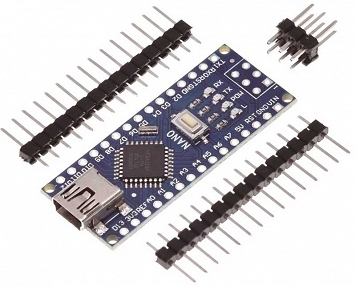Moduł dezvoltare Nano ATmega328 V3.1
-
Dostępność:(234 szt.)
 Jest
Jest
The Nano V3.1 is a small, complete, and breadboard-friendly board based on the ATmega328 (Arduino Nano 3.0) or ATmega168 (Arduino Nano 2.x).It have an integrated on-board USB. As the function, It has almost all the analog and digital pins that the UNO or Duemilanove has and the same function as Duemilanove or UNO. As an upgrade version of Arduino Nano, This Nano V3.1 is 100% compatible to Arduino Nano and its shield and IDEs. On the hardware part, remarkable changes are taken to improve the flexibility and user experience.
Features
Power OK red LED, Green (TX), green (RX) and green (L) LED
Upgraded 5V voltage sourcing, more powerful drive capability
Mini-B USB for programming and serial monitor, TX&RX breakout for application as USB-UART convertor
Surface-Mount ICSP header
Standard 2.54mm spacing DIP (breadboard friendly)
Specification
Microcontroller: ATmega328
Operating Voltage(logic level): 5V
Input Voltage(recommended): 7-12 V
Input Voltage(limits): 6-20 V
Digital I/O Pins: 14 (of which 6 provide PWM output)
Analog Input Pins: 8
DC Current per I/O Pin: 40 mA
Flash Memory: 16 KB (ATmega168) or 32 KB (ATmega328) of which 2 KB used by bootloader
SRAM: 1 KB (ATmega168) or 2 KB (ATmega328)
EEPROM: 512 bytes (ATmega168) or 1 KB (ATmega328)
Clock Speed: 16 MHz
Dimension: 0.73" x 1.70"
Power
The Arduino Nano can be powered via the Mini-B USB connection, 6-20V unregulated external power supply (pin 30), or 5V regulated external
power supply (pin 27). The power source is automatically selected to the highest voltage source. The FTDI FT232RL chip on the Nano is only powered if the board is being powered over USB. As a result, when running on external (non-USB) power, the 3.3V output (which is supplied by the FTDI chip) is not available and the RX and TX LEDs will flicker if digital pins 0 or 1 are high.
Memory
The ATmega168 has 16 KB of flash memory for storing code (of which 2
KB is used for the bootloader); the ATmega328 has 32 KB, (also with 2 KB
used for the bootloader). The ATmega168 has 1 KB of SRAM and 512 bytes
of EEPROM (which can be read and written with the EEPROM library); the ATmega328 has 2 KB of SRAM and 1 KB of EEPROM.

 Angielska
Angielska
 Czeska
Czeska
 Niemiecka
Niemiecka
 Hiszpańska
Hiszpańska
 Francuska
Francuska
 Włoska
Włoska
 Rosyjska
Rosyjska
 Słowacka
Słowacka





